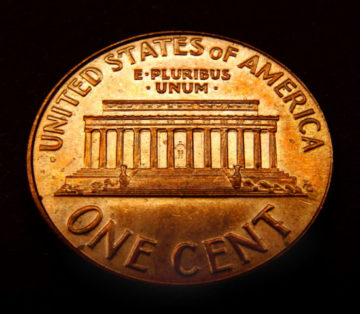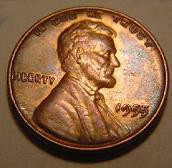
For nearly 50 years now, the Lincoln Memorial has graced the reverse (tails side) of our nation’s Lincoln penny.
Now, believe it or not, we face what is the last year of this highly popular design which has become familiar to all Americans.
Beginning in 2009, the U.S. Mint will embark upon a special, 1-year program of 4 different designs for the reverse of the Lincoln penny to honor the bicentennial of Lincoln’s birth.
In 2010, the U.S. Mint will begin using a new design for the reverse of Lincoln pennies, permanently replacing the Memorial image.
So, are Lincoln Memorial pennies worth lots of money?
Will any of them become valuable in the future?
Value Of Lincoln Pennies
As far as business-strike Lincoln Memorial pennies, the kind struck for circulation (and lacking errors), the short answer essentially is no — Lincoln Memorial pennies generally are not valuable. In fact, typical pieces are worth only face value if worn, and only a tiny premium if in average uncirculated condition, except for a few cases.
Will Lincoln Memorial pennies become valuable in the future? The precise answer is beyond anyone’s guess, but it is safe to assume that Lincoln Memorial pennies, on the whole, will not ever escalate greatly in value, at least for the foreseeable future.
Why? Because many billions of these coins were minted.
Let’s look at the previous Lincoln penny reverse design, the wheat penny. Even though the last wheat penny was struck in 1958, the common dates (many with mintages only a half or a third or less than that of any single Lincoln Memorial date and mint mark combination) are worth little more than 5 to 10 cents in worn condition today.
Perhaps pristine, uncirculated Lincoln Memorial pennies may see handsome price increases in future years, but it is safe to say that the average worn Lincoln Memorial penny may not be worth more than a penny for a very long time to come.
Error Pennies Are The Most Valuable
This is not to say there are no Lincoln Memorial pennies worth more than a penny — or 2 or 10 pennies. Keep an eye out for error pennies
There are many, but doubled dies are among the most valuable. “Doubled die” refers to doubling of all or part of a coin’s design or lettering.
Doubled Die Lincoln Pennies

Known doubled die dates of business strikes (not proofs) include:
- 1969-S: Check for doubling on the lettering and date on the obverse; quite rare and worth more than $50,000 in uncirculated grades
- 1970-S Large Date: Look for doubling on the date and lettering on the obverse; worth upwards of $250 if uncirculated
- 1972: You will see doubling on the obverse, prominent on the date and lettering; worth at least $200 in uncirculated grades
- 1983: You will see doubling on the reverse-side lettering; starts at around $100-125 in uncirculated grades
- 1984: There is doubling in Lincoln’s ear; values start at around $75 in lower uncirculated grades
- 1995: Look for doubling on “In God We Trust” and “Liberty”; prices start at around $10-15 in uncirculated grades
Other Interesting Lincoln Memorial Pennies
Varieties to look for include the following:
- The 1960 large and small date
- 1960-D large and small date
- 1970-S large and small date
- 7 different 1982 varieties:
+ 1982 Copper Large Date
+ 1982 Copper Small Date
+ 1982-D Copper Large Date
+ 1982 Zinc Large Date
+ 1982 Zinc Small Date
+ 1982-D Zinc Large Date
+ 1982-D Zinc Small Date
Generally speaking, these pennies are worth only face value if worn, but can command minimal premiums above face value if uncirculated. Of note are the 1960 small date (with a price tag of around $5 and up if uncirculated) and the 1970-S small date (pulling in over $50 if uncirculated).
Keep in mind that the San Francisco Mint produced business-strike coins (those made for circulation) with mint marks from 1968 through 1974.
Lincoln Penny Mints
Worth noting is the fact that the San Francisco and New York Mint at West Point struck Lincoln pennies years afterward, but did not leave mint marks on these coins.
So, one really cannot tell which cents without mint marks were produced at Philadelphia or at the San Francisco or West Point facilities.
By the way, there are no mint marks on any cents dated 1965, 1966, or 1967 — the U.S. Mint omitted mint marks from all U.S. coins at this time to deter hoarding and collecting activities at a time when the nation suffered a coin shortage.
More About Lincoln Memorial Pennies
There are many great websites for Lincoln Memorial penny collectors to peruse.
- Here’s more information on determining if your 1982 Lincoln cent is copper or zinc.
- A good book on Lincoln pennies is A Guide Book of Lincoln Cents, written by the renowned numismatist Q. David Bowers and published by Whitman.
- Here’s a history of the Lincoln penny.




